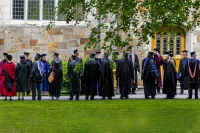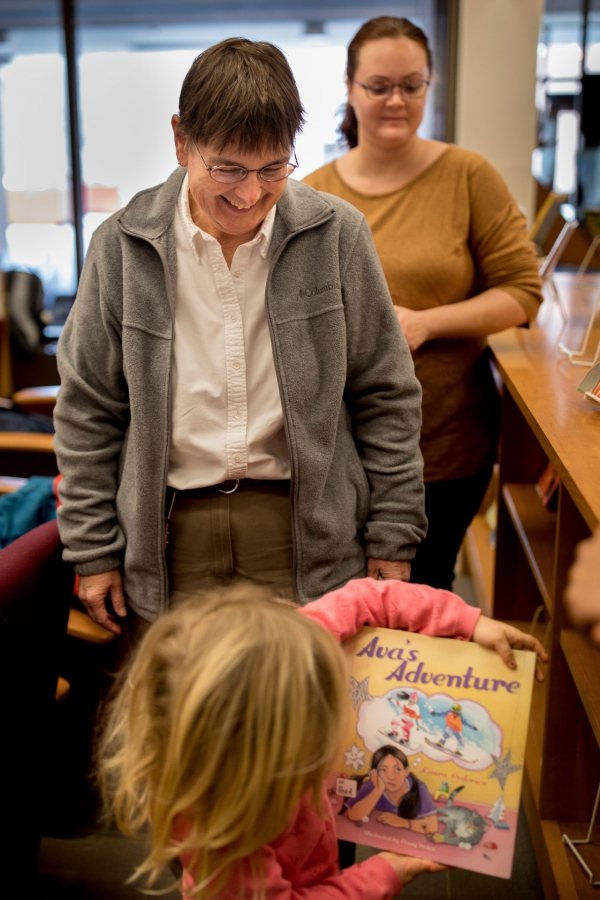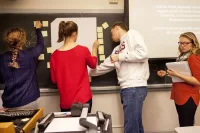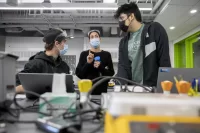
As Bates’ new head of Information and Library Services, Pat Schoknecht’s domain spans centuries’ worth of information technology, from printed words to computing’s cutting edge.
Look more closely and you might be amazed at the scope of responsibilities handled by ILS staff: The programmers and analysts who keep software in tune, processing everything from Admission applications to tuition payments to your Annual Fund gift — and who invent new technology for projects like Bates’ Diverse BookFinder.
Network experts who keep buildings secure, telephones ringing, and the web where you want it, when you want it. Help Desk and classroom technology staff who keep glitches from spoiling your day. Digital media consultants who help you find the best way to tell a story.
And, of course, the librarians and archivists who interpret — and anticipate — your research needs, not to mention tending to the 658,372 objects in Ladd Library’s physical collection, including 589,553 printed books, along with the documentary treasures in Muskie Archives.

Shown with Christina Bell, Ladd Library’s humanities librarian, Pat Schoknecht greets a young patron of the library’s diverse picture book collection during a Martin Luther King Jr. Day reading. (Phyllis Graber Jensen/Bates College)
All this, and much more, falls under Schoknecht’s purview.
Bates is unusual among colleges in placing both its information technology operation and its libraries under a single administrative umbrella.
For Schoknecht, who began last month as vice president for information and library services and college librarian, that distinctive arrangement was part of the appeal of Bates.
Schoknecht came to Bates from Rollins College, where she served as chief information officer and assistant vice president for business services. She talked to us about the evolution of academic information technology departments, an idea about textbooks, and her brother, the biologist.
In terms of your professional or intellectual interests, what are your thoughts about adding oversight of a traditional college library to your portfolio?
I do see a lot of synergies between the library and the IT side. This is an exciting new set of responsibilities.
I’ve worked with libraries very closely, so I think I know something. And then when you actually become the top person, you realize how much you don’t know. And that, of course, is really fun, because now you have some new things to learn.
But you also bring new perspectives because you are an outsider coming in. And those outside eyes can be very important if they lead to questions that cause people to think of new interesting ways to pursue their work. I don’t come in with answers, I come in with questions.
Prior to Rollins, you juggled teaching biology with running a major IT operation — you were director of IT at Wagner College and you directed the Center of Teaching, Learning and Technology at the University of Richmond. How did teaching in the classroom prepare you for what you’re doing now?
It was a gradual sort of thing. This was back in the early ’90s, and so it was early in digital technology. I’m an animal nutritionist, and nutrition is all about metabolism, and metabolism is all about the movement of nutrients through the body. For me, the real excitement of technology was that I could show these pathways to my students rather than just talk about them.
So I was very excited about using it, but I had these trepidations — if it doesn’t work, am I going to look stupid to my students? Is it going to take too much time? Because in the classroom, time is so valuable. It’s got to work right away.
So I think the fact that I’ve lived that experience really helps me to set the right goals for my ILS folks, so that we’re really keeping the faculty’s concerns utmost in our minds.
Generally speaking, how has the IT approach to supporting the academic enterprise evolved?
Academic IT departments have gotten far better and much more professionalized than we were 10 or 20 years ago. You know, the way the IT department started at most schools was usually with a computer science faculty member who started doing some things, and it was pretty ad hoc.
And now we’re a professional department that can provide the level of support to faculty that they need. More than anything, I think it’s been about process — working through the processes that allow the IT staff to do what they need to do, but to do it in a manner that meets the needs of the faculty and the students.
For example, we understand the business cycles of the educational system. The admission business cycle is different than advancement’s business cycle, which is different than the academic year, which is the faculty’s business cycle. Since IT impacts all of those, we have to adapt ourselves around the business cycles of the institution, and we’ve just gotten much better at that.
What’s an initiative happening right now that, to you, epitomizes Bates ILS in action?
We are beginning some projects around open educational resources, and these are projects that will include both the library and the IT parts of ILS.
The idea is to think about how we can find, or maybe create, materials that would help faculty to replace textbooks in their courses — and help make the Bates education more affordable by decreasing textbook costs. We’re going to be looking for faculty who want to partner with us in that endeavor.
Something that’s struck me during my 16 years at Bates is the way that the library has become less of a heads-down, quiet repository of information. Now it’s more a site of dynamic interaction between students. It’s not so much “shhh” anymore.
The library is the academic center of campus, but we know that students learn best when they can interact with other people, when they’re in collaborative learning environments. And so the library needs to be a place where they can find the resources that they need, using that word very broadly — a place where they can either work alone because that’s what they want to do, or in pairs or small groups.
I was talking to somebody the other day who I think said it best: “The library is the place where intentional learning should be happening.” We want people to come in with that intentionality and we want to provide them with the services that help them accomplish whatever that intention is.
Was there anything in your early life that would have suggested you’d be doing what you are now?
Absolutely nothing! I was truly a committed biologist throughout all of my young life, teen years, into college, throughout graduate school. My older brother was, for a while, also a biologist and he’s 13 years older than I am. So when he was at college I was a little kid, and he would bring his fetal pig home over Christmas break to dissect. I was the one in the basement with him doing that because that was so exciting to me.
I really didn’t get into IT for the IT component, I got into IT because of the teaching component. You know, for me it was all about, “Here’s a tool that’s going to enhance my teaching, and so I need to know more about this tool.”
So I really went from being that committed biologist to a committed teacher — and then from there I said, “Well, I can impact 100, 200 students a year through my teaching. If I move into a technology role, I can impact 2,000 students a year.” And that felt like the right thing to do.




